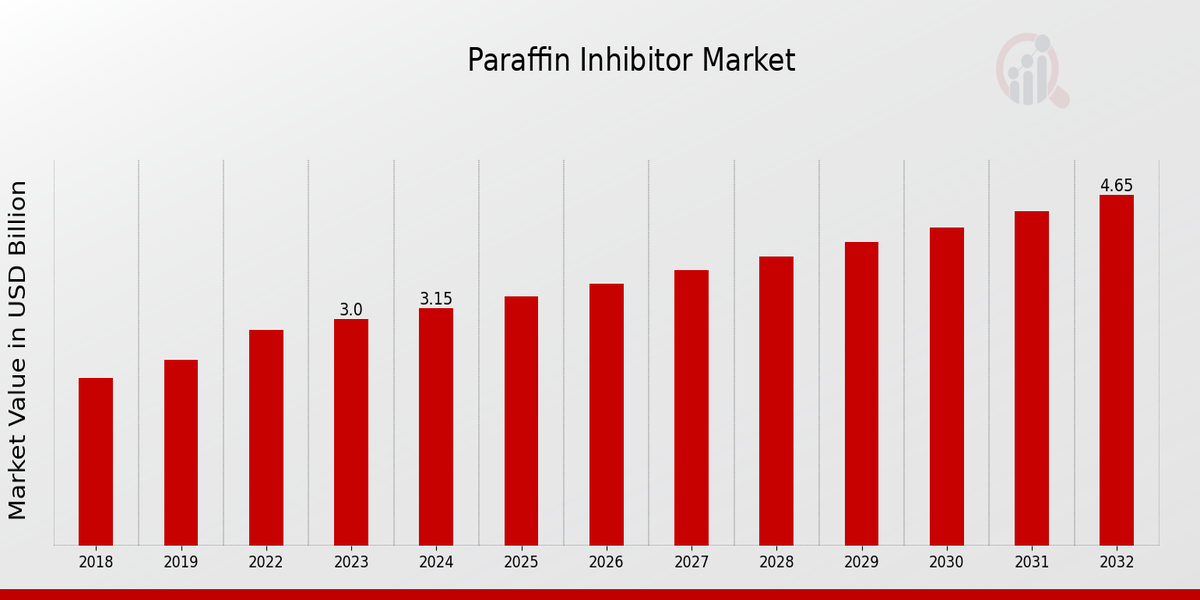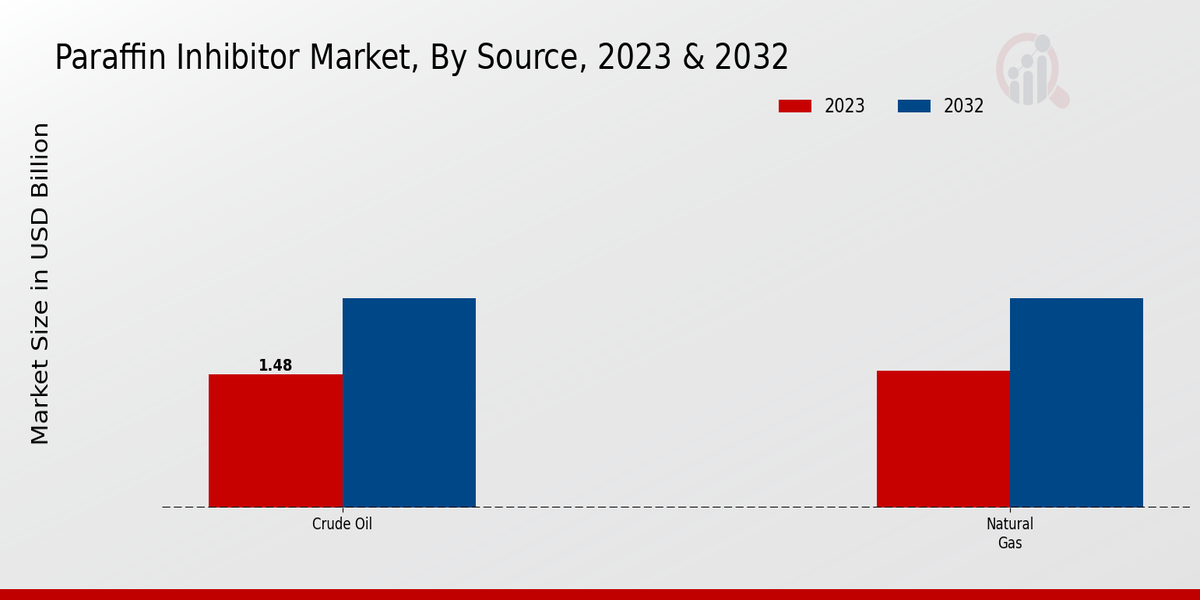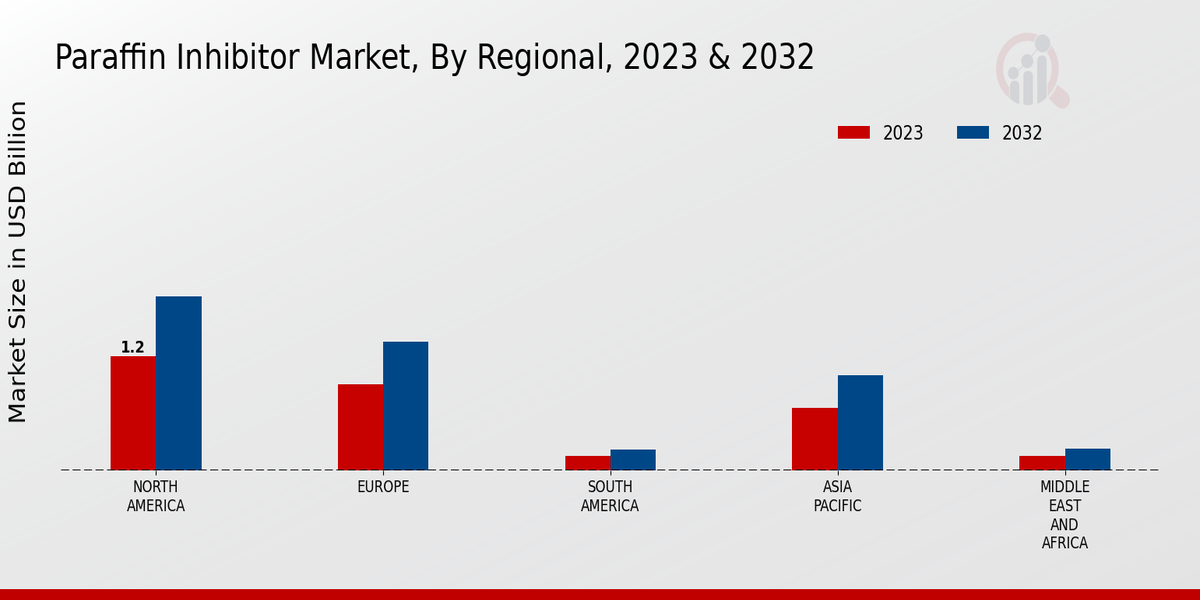Global Paraffin Inhibitor Market Overview
The Paraffin Inhibitor Market Size was estimated at 2.86 (USD Billion) in 2022. The Paraffin Inhibitor Industry is expected to grow from 3.0(USD Billion) in 2023 to 4.65 (USD Billion) by 2032. The Paraffin Inhibitor Market CAGR (growth rate) is expected to be around 4.99% during the forecast period (2024 - 2032).
Key Paraffin Inhibitor Market Trends Highlighted
The paraffin inhibitor market is witnessing a surge in demand due to its effectiveness in preventing the deposition of paraffin crystals in oil and gas pipelines. The growing reliance on oil and gas as primary energy sources, coupled with the expansion of the oil and gas industry, is driving the market's growth.Key market drivers include the increasing production and transportation of crude oil and natural gas, rising oil and gas exploration and production activities, and the need for efficient and reliable flow assurance in oil and gas pipelines. The market is also benefiting from advancements in inhibitor chemistry and the development of environmentally friendly inhibitors.Recent trends include the growing adoption of paraffin inhibitors with higher thermal stability and wider compatibility, the increasing use of non-toxic and biodegradable inhibitors to meet environmental regulations, and the development of inhibitors tailored to specific oil and gas field conditions. The market is expected to continue its growth trajectory in the coming years, driven by the increasing demand for oil and gas, technological advancements, and environmental concerns.

Source Primary Research, Secondary Research, MRFR Database and Analyst Review
Paraffin Inhibitor Market Drivers
Increasing Demand for Paraffin Inhibitors in Oil and Gas Industry
Paraffin inhibitors are chemicals that are added to crude oil and natural gas to prevent the formation of paraffin deposits. Paraffin deposits can clog pipelines and equipment, reducing production and increasing maintenance costs. The increasing demand for oil and gas is driving the growth of the paraffin inhibitor market. As oil and gas production increases, so does the need for paraffin inhibitors to prevent the formation of paraffin deposits. The Paraffin Inhibitor Market Industry is expected to grow from USD 3.0 billion in 2023 to USD 4.65 billion by 2032, at a CAGR of 4.99%. The oil and gas industry is the largest consumer of paraffin inhibitors.Paraffin inhibitors are used in a variety of applications in the oil and gas industry, including Well treatment. Paraffin inhibitors are used to prevent the formation of paraffin deposits in oil and gas wells. Paraffin deposits can reduce the flow of oil and gas from the well, and can also damage the well equipment. Pipeline transportation Paraffin inhibitors are used to prevent the formation of paraffin deposits in oil and gas pipelines. Paraffin deposits can reduce the flow of oil and gas through the pipeline, and can also damage the pipeline.Storage Paraffin inhibitors are used to prevent the formation of paraffin deposits in oil and gas storage tanks. Paraffin deposits can reduce the storage capacity of the tank, and can also damage the tank. The increasing demand for oil and gas is expected to continue to drive the growth of the paraffin inhibitor market. As oil and gas production increases, so does the need for paraffin inhibitors to prevent the formation of paraffin deposits.
Growing Awareness of the Benefits of Paraffin Inhibitors
The growing awareness of the benefits of paraffin inhibitors is another factor driving the growth of the paraffin inhibitor market. Paraffin inhibitors can provide a number of benefits to oil and gas producers, including Increased production. Paraffin inhibitors can help to increase oil and gas production by preventing the formation of paraffin deposits. Paraffin deposits can reduce the flow of oil and gas from the well and can also damage the well equipment.Reduced maintenance costs Paraffin inhibitors can help to reduce maintenance costs by preventing the formation of paraffin deposits. Paraffin deposits can clog pipelines and equipment, increasing maintenance costs. Improved safety Paraffin inhibitors can help to improve safety by preventing the formation of paraffin deposits. Paraffin deposits can create a fire hazard and can also lead to explosions. The growing awareness of the benefits of paraffin inhibitors is expected to continue to drive the growth of the paraffin inhibitor market.
Government Regulations on the Use of Paraffin Inhibitors
Government regulations on the use of paraffin inhibitors are another factor driving the growth of the paraffin inhibitor market. In many countries, the use of paraffin inhibitors is regulated by government agencies. These regulations are designed to protect the environment and human health. The regulations on the use of paraffin inhibitors vary from country to country. In some countries, the use of paraffin inhibitors is restricted to certain applications.In other countries, the use of paraffin inhibitors is banned altogether. The government regulations on the use of paraffin inhibitors are expected to continue to evolve as new information about the environmental and health effects of paraffin inhibitors becomes available.
Paraffin Inhibitor Market Segment Insights
Paraffin Inhibitor Market Source Insights
Source Segment Insights and Overview The Paraffin Inhibitor Market can be segmented on the basis of its source into crude oil and natural gas. In 2024, the crude oil segment is estimated to hold nearly two-thirds of the overall market share. The dominance of crude oil in the market can be attributed to the increasing production and consumption of crude oil globally, particularly in emerging economies. Natural gas, on the other hand, is projected to exhibit a steady growth rate over the next six years, owing to the rising demand for cleaner energy sources and the growing awareness of environmental concerns.As a result, the natural gas segment is anticipated to capture a significant share of the Paraffin Inhibitor Market by 2032. Key factors driving the growth of the paraffin inhibitor market include the increasing demand for refined petroleum products, stringent regulations regarding the production and transportation of crude oil, and the growing need for efficient and cost-effective ways to prevent paraffin deposition in pipelines and other oil and gas infrastructure. Market participants are focusing on developing innovative paraffin inhibitors with improved performance and reduced environmental impact.Key players in the industry are investing in research and development to improve the efficiency of paraffin inhibitors and expand their applications in various end-use industries. Overall, the Paraffin Inhibitor Market is expected to witness significant growth in the coming years, driven by the expanding oil and gas industry and the rising demand for refined petroleum products.

Source Primary Research, Secondary Research, MRFR Database and Analyst Review
Paraffin Inhibitor Market Application Insights
The Paraffin Inhibitor Market is segmented based on application into Oil Gas, Water Treatment, Personal Care, Cosmetics and Food Beverage. Among these segments, the Oil Gas segment is expected to account for the largest market share in 2023, owing to the increasing demand for paraffin inhibitors in the oil and gas industry to prevent the formation of paraffin deposits in pipelines and other equipment. The Water Treatment segment is expected to witness significant growth over the forecast period due to the rising demand for paraffin inhibitors in water treatment applications, such as cooling water systems and desalination plants.The Personal Care segment is expected to account for a moderate market share, driven by the growing demand for paraffin inhibitors in personal care products, such as hair conditioners and lotions. The Cosmetics segment is expected to witness steady growth over the forecast period, owing to the increasing use of paraffin inhibitors in cosmetics, such as lipsticks and creams. The Food Beverage segment is expected to account for a small market share, driven by the demand for paraffin inhibitors in food and beverage applications, such as food packaging and beverage processing.
Paraffin Inhibitor Market Type Insights
The Paraffin Inhibitor Market is segmented by type into oil-soluble inhibitors and water-soluble inhibitors. Oil-soluble inhibitors accounted for the largest share of the Paraffin Inhibitor Market revenue in 2023, owing to their high efficiency in preventing paraffin deposition in oil pipelines. Water-soluble inhibitors are expected to grow at a faster rate during the forecast period due to their growing use in offshore oil and gas applications. The increasing demand for paraffin inhibitors from the oil and gas industry is a major factor driving the growth of the Paraffin Inhibitor Market.The growing awareness of the importance of paraffin inhibition in preventing pipeline blockages is also contributing to the market growth.
Paraffin Inhibitor Market Chemical Composition Insights
The chemical composition segment of the Paraffin Inhibitor Market is segmented into styrene-maleic acid copolymers, polyethylene-co-vinyl acetate copolymers, phosphonates and imidazolines. Styrene-maleic acid copolymers are expected to hold the largest market share due to their excellent film-forming properties and high thermal stability. Polyethylene-co-vinyl acetate copolymers are also expected to witness significant growth due to their low cost and good compatibility with other chemicals. Phosphonates are expected to witness moderate growth due to their ability to inhibit paraffin deposition at low concentrations.Imidazolines are expected to witness the slowest growth due to their higher cost and limited availability. The Paraffin Inhibitor Market is expected to reach USD 3.45 billion by 2024, growing at a CAGR of 5.2% from 2023 to 2024.
Paraffin Inhibitor Market Regional Insights
The Paraffin Inhibitor Market is segmented into North America, Europe, APAC, South America and MEA. Among these regions, North America accounted for the largest share of the market in 2023 and is projected to maintain its dominance throughout the forecast period. The growth in this region can be attributed to the increasing demand for paraffin inhibitors in the oil and gas industry, as well as the presence of major oil and gas companies in the region. Europe is expected to be the second-largest market for paraffin inhibitors, followed by APAC.The APAC region is expected to witness significant growth in the coming years due to the increasing demand for paraffin inhibitors in the automotive and industrial sectors. South America and MEA are expected to account for a smaller share of the market but are expected to witness steady growth over the forecast period.

Source Primary Research, Secondary Research, MRFR Database and Analyst Review
Paraffin Inhibitor Market Key Players And Competitive Insights
Major players in Paraffin Inhibitor Market industry are constantly striving to gain a competitive edge over their rivals. Leading Paraffin Inhibitor Market players are focusing on innovation and development of new technologies to enhance the performance and efficiency of their products. They are also investing in research and development to create new solutions that meet the evolving needs of customers. Furthermore, mergers and acquisitions are becoming increasingly common in the Paraffin Inhibitor Market sector as companies seek to expand their market share and gain access to new technologies and markets. The competitive landscape of the Paraffin Inhibitor Market is expected to remain highly dynamic, with new entrants and disruptive technologies emerging.A prominent competitor in the Paraffin Inhibitor Market is Baker Hughes, a leader in the oil and gas industry. The company offers a wide range of paraffin inhibitor solutions, including chemical and mechanical inhibitors. Baker Hughes has a strong presence in key markets around the world and benefits from its extensive distribution network. Another key competitor is Halliburton, which provides a comprehensive suite of paraffin inhibitor products and services. Halliburton has a long history of innovation in the oil and gas industry and is known for its high-quality products and customer service.Furthermore, Schlumberger is a multinational oilfield services company that offers a broad portfolio of paraffin inhibitor solutions. The company has a presence and a strong reputation for delivering reliable and effective products. Other notable competitors in the Paraffin Inhibitor Market include Ecolab, Champion Technologies, and Innospec. These companies are investing heavily in research and development to develop innovative paraffin inhibitor solutions that meet the specific needs of their customers. The competitive landscape of the Paraffin Inhibitor Market is expected to remain competitive, with new entrants and disruptive technologies emerging.
Key Companies in the Paraffin Inhibitor Market Include
- Ashland
- Huntsman Corporation
- Innospec
- BASF
- Halliburton
- Wacker Chemie
- Clariant
- Schlumberger
- Stepan Company
- ChemTreat
- Nouryon
- Solvay
- Croda International
- Dow
- Baker Hughes
Paraffin Inhibitor Market Industry Developments
The paraffin inhibitor market is expected to witness steady growth over the forecast period of 2024-2032. In 2023, the market was valued at approximately USD 3.0 billion, and it is projected to reach USD 4.65 billion by 2032, exhibiting a CAGR of 4.99%. Increasing demand for paraffin inhibitors in various industries, such as oil and gas and chemicals, is primarily driving the market growth.Recent news and developments in the paraffin inhibitor market include- In January 2023, BASF introduced a new paraffin inhibitor, Lutensol ON 7910, specifically designed for use in low-temperature applications.- In March 2023, Clariant launched a new range of high-performance paraffin inhibitors, Ceridust 8400 series, for use in harsh operating conditions.- In June 2023, Nouryon announced the expansion of its paraffin inhibitor production capacity in Singapore to meet growing demand from the Asia-Pacific region.These developments reflect the ongoing advancements and innovations in the paraffin inhibitor market, driven by the increasing demand for effective and efficient solutions to prevent paraffin deposition in various industrial applications.
Paraffin Inhibitor Market Segmentation Insights
Paraffin Inhibitor Market Source Outlook
Paraffin Inhibitor Market Application Outlook
- Oil Gas
- Water Treatment
- Personal Care
- Cosmetics
- Food Beverage
Paraffin Inhibitor Market Type Outlook
- Oil-Soluble Inhibitors
- Water-Soluble Inhibitors
Paraffin Inhibitor Market Chemical Composition Outlook
- Styrene-Maleic Acid Copolymers
- Polyethylene-Co-Vinyl Acetate Copolymers
- Phosphonates
- Imidazolines
Paraffin Inhibitor Market Regional Outlook
-
North America
-
Europe
-
South America
-
Asia Pacific
-
Middle East and Africa
| Report Attribute/Metric |
Details |
| Market Size 2022 |
2.86(USD Billion) |
| Market Size 2023 |
3.0(USD Billion) |
| Market Size 2032 |
4.65(USD Billion) |
| Compound Annual Growth Rate (CAGR) |
4.99% (2024 - 2032) |
| Report Coverage |
Revenue Forecast, Competitive Landscape, Growth Factors, and Trends |
| Base Year |
2023 |
| Market Forecast Period |
2024 - 2032 |
| Historical Data |
2019 - 2023 |
| Market Forecast Units |
USD Billion |
| Key Companies Profiled |
Ashland, Huntsman Corporation, Innospec, BASF, Halliburton, Wacker Chemie, Clariant, Schlumberger, Stepan Company, ChemTreat, Nouryon, Solvay, Croda International, Dow, Baker Hughes |
| Segments Covered |
Source, Application, Type, Chemical Composition, Regional |
| Key Market Opportunities |
1. Growth in crude oil production 2. Increasing demand from refineries 3. Rising awareness of paraffin inhibitor benefits 4. Technological advancements 5. Expansion of downstream applications |
| Key Market Dynamics |
1. Increasing demand from oil amp gas industry 2. Rising adoption of paraffin inhibitors in refineries 3. Growing awareness of paraffin inhibitors benefits 4. Technological advancements and product innovations 5. Environmental regulations and industry standards |
| Countries Covered |
North America, Europe, APAC, South America, MEA |
Frequently Asked Questions (FAQ) :
The Paraffin Inhibitor Market size is expected to reach USD 4.65 billion by 2032, exhibiting a CAGR of 4.99% during the forecast period (2024-2032).
North America is expected to dominate the Paraffin Inhibitor Market with a revenue share of 38.5% in 2023, owing to the increasing demand for paraffin inhibitors from the oil and gas industry in the region.
The oil and gas application segment is expected to register the highest growth rate in the Paraffin Inhibitor Market during the forecast period, due to the rising demand for paraffin inhibitors to prevent the formation of paraffin deposits in oil and gas pipelines.
Some of the key competitors in the Paraffin Inhibitor Market include BASF SE, Clariant AG, Croda International Plc, Baker Hughes Company, Halliburton Company, Schlumberger Limited, Ecolab Inc. and ChampionX Corporation.
The increasing demand for paraffin inhibitors from the oil and gas industry, growing awareness about the benefits of paraffin inhibitors, and technological advancements in the development of more efficient and environmentally friendly paraffin inhibitors are the key trends driving the growth of the Paraffin Inhibitor Market.
The volatility in crude oil prices, stringent environmental regulations, and the development of alternative technologies for paraffin inhibition are some of the key challenges faced by the Paraffin Inhibitor Market.
The COVID-19 pandemic had a negative impact on the Paraffin Inhibitor Market in the short term due to the decline in oil and gas production and exploration activities. However, the market is expected to recover in the post-pandemic period as economic activities resume and the demand for paraffin inhibitors increases.The COVID-19 pandemic had a negative impact on the Paraffin Inhibitor Market in the short term due to the decline in oil and gas production and exploration activities. However, the market is expected to recover in the post-pandemic period as economic activities resume and the demand for paraffin inhibitors increases.
The growing demand for paraffin inhibitors from emerging economies, increasing adoption of paraffin inhibitors in non-oil and gas applications, and the development of new and innovative paraffin inhibitor technologies are some of the key opportunities for growth in the Paraffin Inhibitor Market.
The key factors to consider when selecting a paraffin inhibitor include the type of oil or gas being treated, the operating conditions, the desired level of inhibition, and the environmental compatibility of the inhibitor.
Paraffin inhibitors are subject to regulatory requirements in various countries around the world, including those related to their environmental impact and safety. Manufacturers of paraffin inhibitors must comply with these regulations to ensure the safe and responsible use of their products.

















